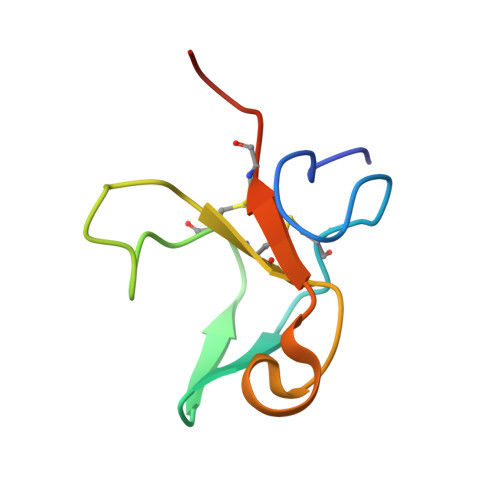The col-1 module of human matrix metalloproteinase-2 (MMP-2): structural/functional relatedness between gelatin-binding fibronectin type II modules and lysine-binding kringle domains.
Gehrmann, M., Briknarova, K., Banyai, L., Patthy, L., Llinas, M.(2002) Biol Chem 383: 137-148
- PubMed: 11928808
- DOI: https://doi.org/10.1515/BC.2002.014
- Primary Citation of Related Structures:
1KS0 - PubMed Abstract:
Human matrix metalloproteinase-2 (MMP-2) contains three in-tandem fibronectin type II (FII) repeats that bind gelatin. Here, we report the NMR solution structure of the first FII module of MMP-2 (col-1). The latter is described as a characteristic, globular FII fold containing two beta-sheets, a stretch of 3(1)-helix, a turn of alpha-helix, and an exposed hydrophobic surface lined with aromatic residues. We show that col-1 binds (Pro-Pro-Gly)6, a mimic of gelatin, with a Ka of approx. 0.42 mm(-1), and that its binding site involves a number of aromatic residues as well as Arg34, as previously found for the second and third homologous repeats. Moreover, the affinity of the in-tandem col-1+2 construct (col-12) toward the longer ligand (Pro-Pro-Gly)12 is twice that for (Pro-Pro-Gly)6, as expected from mass action. A detailed structural comparison between FII and kringle domains indicates that four main conformational features are shared: two antiparallel beta-sheets, a central 3(1)-helix, and the quasiperpendicular orientation of the two proximal Cys-Cys bonds. Structure superposition by optimizing overlap of cystine bridge areas results in close juxtaposition of their main beta-sheets and 31-helices, and reveals that the gelatin binding site of FII modules falls at similar locations and exhibits almost identical topological features to those of the lysine binding site of kringle domains. Thus, despite the minor (<15%) consensus sequence relating FII modules to kringles, there is a strong folding and binding site structural homology between the two domains, enforced by key common conformational determinants.
- Department of Chemistry, Carnegie Mellon University, Pittsburgh, PA 15213, USA.
Organizational Affiliation:
















